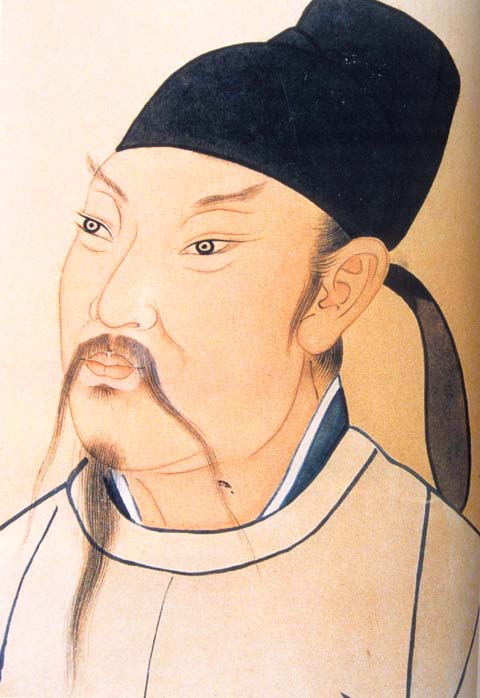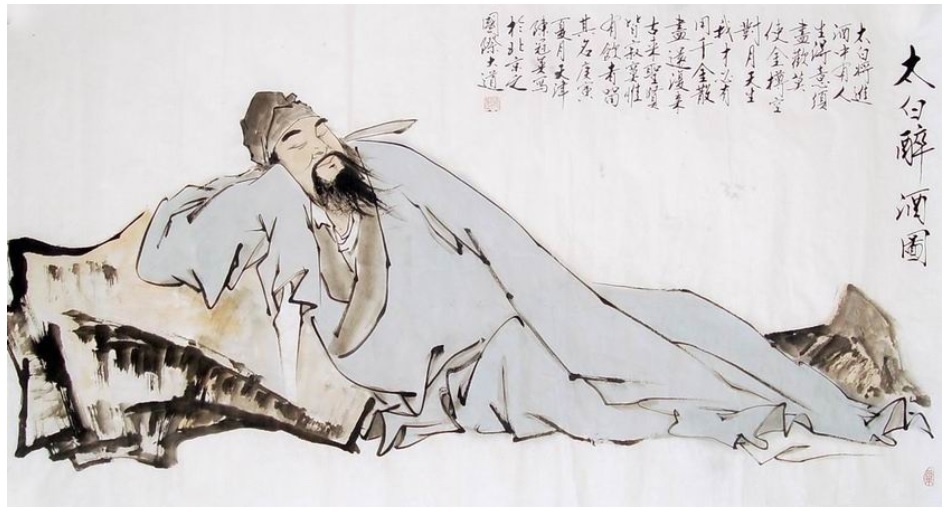Quiet Night Thought on:
[Wikipedia]
[Google]
[Amazon]
 Quiet Night Thought () is a famous poem written by the
Quiet Night Thought () is a famous poem written by the

静かな夜に『静夜思』を思う
p.171. The insertion of the character (''míng'' "light/bright") into poetry was common practice during the Ming dynasty (), whose Chinese name features this character. For a 17th-century edition of the poem, see the example, with notes, in " Rare Book Preservation Society#Li Bai Tang Poem".
 Quiet Night Thought () is a famous poem written by the
Quiet Night Thought () is a famous poem written by the Tang Dynasty
The Tang dynasty (, ; zh, t= ), or Tang Empire, was an Dynasties in Chinese history, imperial dynasty of China that ruled from 618 to 907 AD, with an Zhou dynasty (690–705), interregnum between 690 and 705. It was preceded by the Sui dyn ...
poet, Li Bai
Li Bai (, 701–762), also pronounced as Li Bo, courtesy name Taibai (), was a Chinese poet, acclaimed from his own time to the present as a brilliant and romantic figure who took traditional poetic forms to new heights. He and his friend Du F ...
(also known as Li Bo or Li Po).
Text
The text below is aQing-dynasty
The Qing dynasty ( ), officially the Great Qing,, was a Manchu-led imperial dynasty of China and the last orthodox dynasty in Chinese history. It emerged from the Later Jin dynasty founded by the Jianzhou Jurchens, a Tungusic-speaki ...
version, with Mandarin pronunciation. It is taught to children in both Taiwanese
Taiwanese may refer to:
* Taiwanese language, another name for Taiwanese Hokkien
* Something from or related to Taiwan (Formosa)
* Taiwanese aborigines, the indigenous people of Taiwan
* Han Taiwanese, the Han people of Taiwan
* Taiwanese people, r ...
and Chinese schools.

Variants
There are other versions of this poem that replace "the bright moonlight" () with "I see the moonlight" () and/or "gazing at the bright moon" () with "gazing at the mountain and the moon" ().p.171. The insertion of the character (''míng'' "light/bright") into poetry was common practice during the Ming dynasty (), whose Chinese name features this character. For a 17th-century edition of the poem, see the example, with notes, in " Rare Book Preservation Society#Li Bai Tang Poem".
Background and evaluation
Li drew inspiration for the poem through personal experiences as aConfucian
Confucianism, also known as Ruism or Ru classicism, is a system of thought and behavior originating in ancient China. Variously described as tradition, a philosophy, a religion, a humanistic or rationalistic religion, a way of governing, or ...
scholar detached from his hometown. In the times of Imperial China
The earliest known written records of the history of China date from as early as 1250 BC, from the Shang dynasty (c. 1600–1046 BC), during the reign of king Wu Ding. Ancient historical texts such as the '' Book of Documents'' (early chapt ...
, scholars and artisans affiliated with the court
A court is any person or institution, often as a government institution, with the authority to adjudicate legal disputes between parties and carry out the administration of justice in civil, criminal, and administrative matters in acco ...
were often detached from their hometowns for extended periods of times as part of their duties and loyalties as courtiers
A courtier () is a person who attends the royal court of a monarch or other royalty. The earliest historical examples of courtiers were part of the retinues of rulers. Historically the court was the centre of government as well as the official ...
or worthy subjects to the Emperor of China
''Huangdi'' (), translated into English as Emperor, was the superlative title held by monarchs of China who ruled various imperial regimes in Chinese history. In traditional Chinese political theory, the emperor was considered the Son of Heav ...
. While it was expected in traditional Confucian ritual
A ritual is a sequence of activities involving gestures, words, actions, or objects, performed according to a set sequence. Rituals may be prescribed by the traditions of a community, including a religious community. Rituals are characterized ...
to remain a loyal subject to the Emperor and abide by the Emperor's wishes, filial piety
In Confucianism, Chinese Buddhism, and Daoist ethics, filial piety (, ''xiào'') (Latin: pietas) is a virtue of respect for one's parents, elders, and ancestors. The Confucian '' Classic of Filial Piety'', thought to be written around the lat ...
also formed one of the foundations of Confucian thought, and emphasised upon the importance of embracing and honouring one's ancestry and roots. However, the Emperor was also considered the "Father" of all his subjects, and so his courtiers were also required to express their filial duties to the Emperor. Through the poem, Li Bai fulfils responsibilities of filial piety to both Emperor and his ascendants as he expresses his yearning for his hometown, in accordance with Confucian values, as well as obedience towards the sad obligation of remaining loyal to imperial edict, again in accordance to Confucian values of filial piety. Indeed, the poem alludes to the August moon and therefore the Mid-Autumn Festival
The Mid-Autumn Festival ( Chinese: / ), also known as the Moon Festival or Mooncake Festival, is a traditional festival celebrated in Chinese culture. Similar holidays are celebrated in Japan (), Korea (), Vietnam (), and other countries in E ...
. The Mid-Autumn Festival serves as a highly important festival in Chinese culture
Chinese culture () is one of the world's oldest cultures, originating thousands of years ago. The culture prevails across a large geographical region in East Asia and is extremely diverse and varying, with customs and traditions varying grea ...
for its adherence to Chinese family values, and is traditionally associated with family reunion
A family reunion is an occasion when many members of an extended family congregate. Sometimes reunions are held regularly, for example on the same date of every year.
A typical family reunion will assemble for a meal, some recreation and discussi ...
. Li is therefore lamenting over the impossibility of family reunion due to the importance of the imperial edict, yet stresses the importance of valuing one's origin even amidst the impossibility of reunion.
The poem is one of Li's shi poems, structured as a single quatrain in five-character regulated verse Regulated verse – also known as Jintishi () – is a development within Classical Chinese poetry of the '' shi'' main formal type. Regulated verse is one of the most important of all Classical Chinese poetry types. Although often regarded as a T ...
with a simple AABA rhyme scheme
A rhyme scheme is the pattern of rhymes at the end of each line of a poem or song. It is usually referred to by using letters to indicate which lines rhyme; lines designated with the same letter all rhyme with each other.
An example of the ABAB r ...
(at least in its original Middle Chinese
Middle Chinese (formerly known as Ancient Chinese) or the Qieyun system (QYS) is the historical variety of Chinese recorded in the '' Qieyun'', a rime dictionary first published in 601 and followed by several revised and expanded editions. The ...
dialect as well as the majority of contemporary Chinese dialects
Chinese, also known as Sinitic, is a branch of the Sino-Tibetan language family consisting of hundreds of local varieties, many of which are not mutually intelligible. Variation is particularly strong in the more mountainous southeast of main ...
). It is short and direct in accordance with the guidelines for shi poetry, and cannot be conceived as purely a personal poem, but as a poem relatable to all those detached from their hometowns out of obligation. Hence, in contrast to Li Bai's longer, more free-form gushi, "Quiet Night Thought" is vague, yet expresses solemnity and yearning through a combination of its night-time imagery and its spare form.
Legacy
Since its conception during theTang Dynasty
The Tang dynasty (, ; zh, t= ), or Tang Empire, was an Dynasties in Chinese history, imperial dynasty of China that ruled from 618 to 907 AD, with an Zhou dynasty (690–705), interregnum between 690 and 705. It was preceded by the Sui dyn ...
, "Quiet Night Thought" remains one of Li Bai's most famous and memorable poems. It is featured in classic Chinese poetry anthologies
In book publishing, an anthology is a collection of literary works chosen by the compiler; it may be a collection of plays, poems, short stories, songs or excerpts by different authors.
In genre fiction, the term ''anthology'' typically categ ...
such as the ''Three Hundred Tang Poems
The ''Three Hundred Tang Poems'' () is an anthology of poems from the Chinese Tang dynasty (618–907). It was first compiled around 1763 by Sun Zhu (1722–1778Yu, 64–65), who was a Qing Dynasty scholar and was also known as Hengtang Tuishi ( ...
'' and is popularly taught in Chinese-language schools
A school is an educational institution designed to provide learning spaces and learning environments for the teaching of students under the direction of teachers. Most countries have systems of formal education, which is sometimes compulsor ...
as part of Chinese literature curricula. It is also commonly taught as one of the earliest works of Chinese poetry
Poetry (derived from the Greek '' poiesis'', "making"), also called verse, is a form of literature that uses aesthetic and often rhythmic qualities of language − such as phonaesthetics, sound symbolism, and metre − to evoke meani ...
in the education of juniors for its relative simplicity and straightforward yet effective use of imagery to provoke basic Confucian values.
See also
*Li Bai
Li Bai (, 701–762), also pronounced as Li Bo, courtesy name Taibai (), was a Chinese poet, acclaimed from his own time to the present as a brilliant and romantic figure who took traditional poetic forms to new heights. He and his friend Du F ...
* Tang poetry
Tang poetry () refers to poetry written in or around the time of or in the characteristic style of China's Tang dynasty, (June 18, 618 – June 4, 907, including the 690–705 reign of Wu Zetian) and/or follows a certain style, often considered ...
References
{{ Chinese poetry Tang dynasty poetry Chinese poems Li Bai